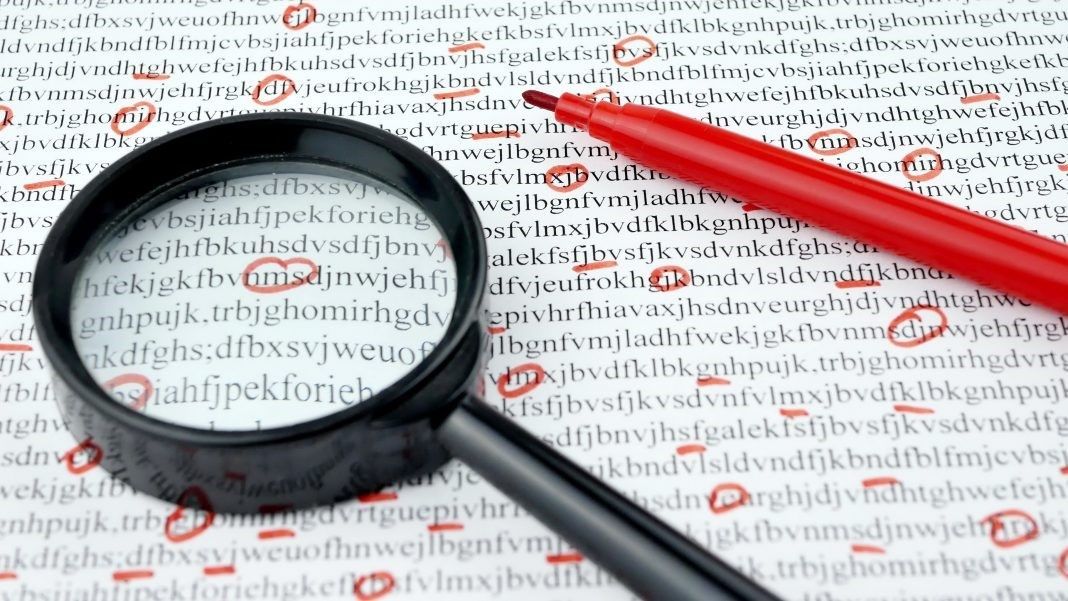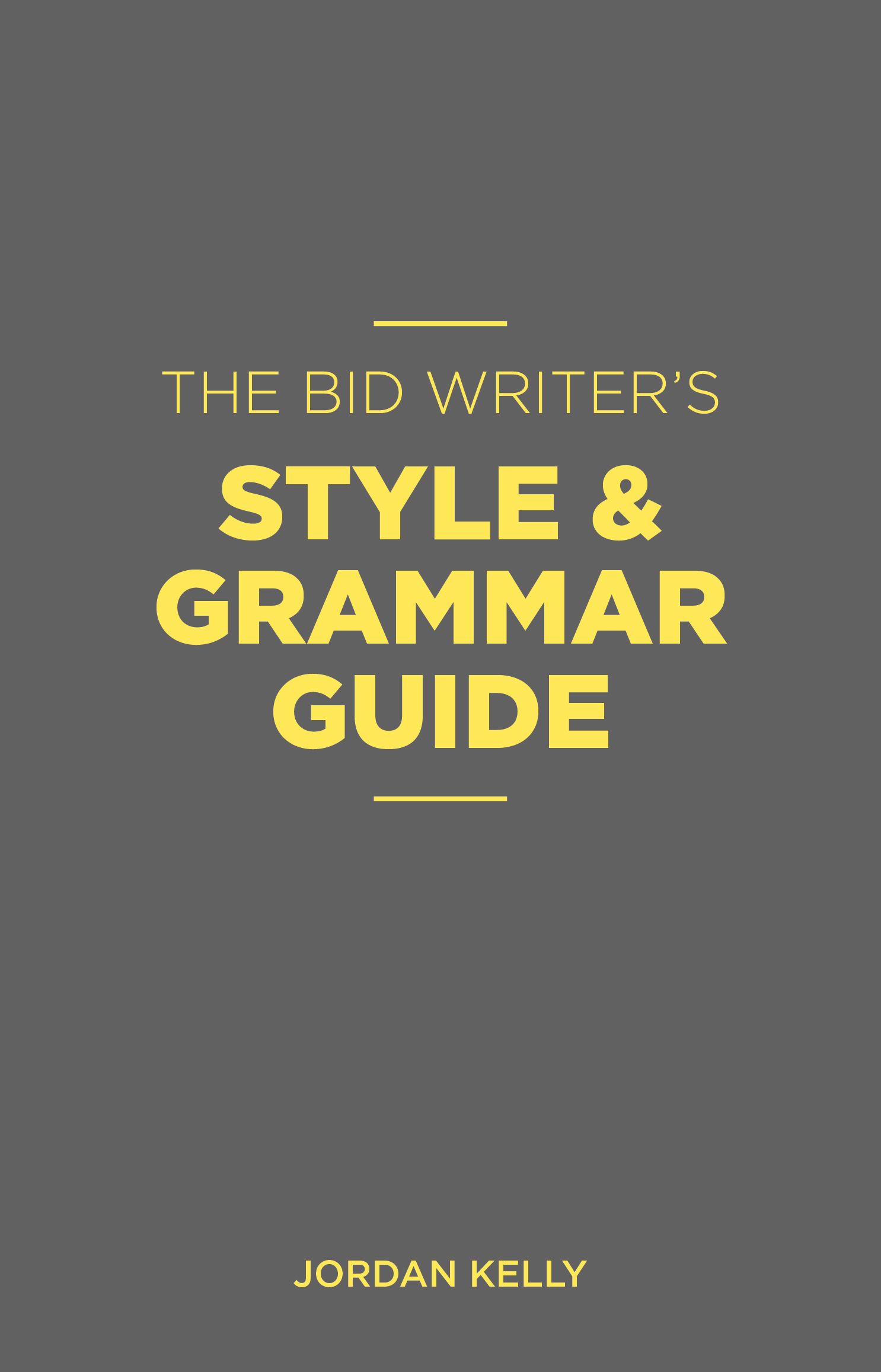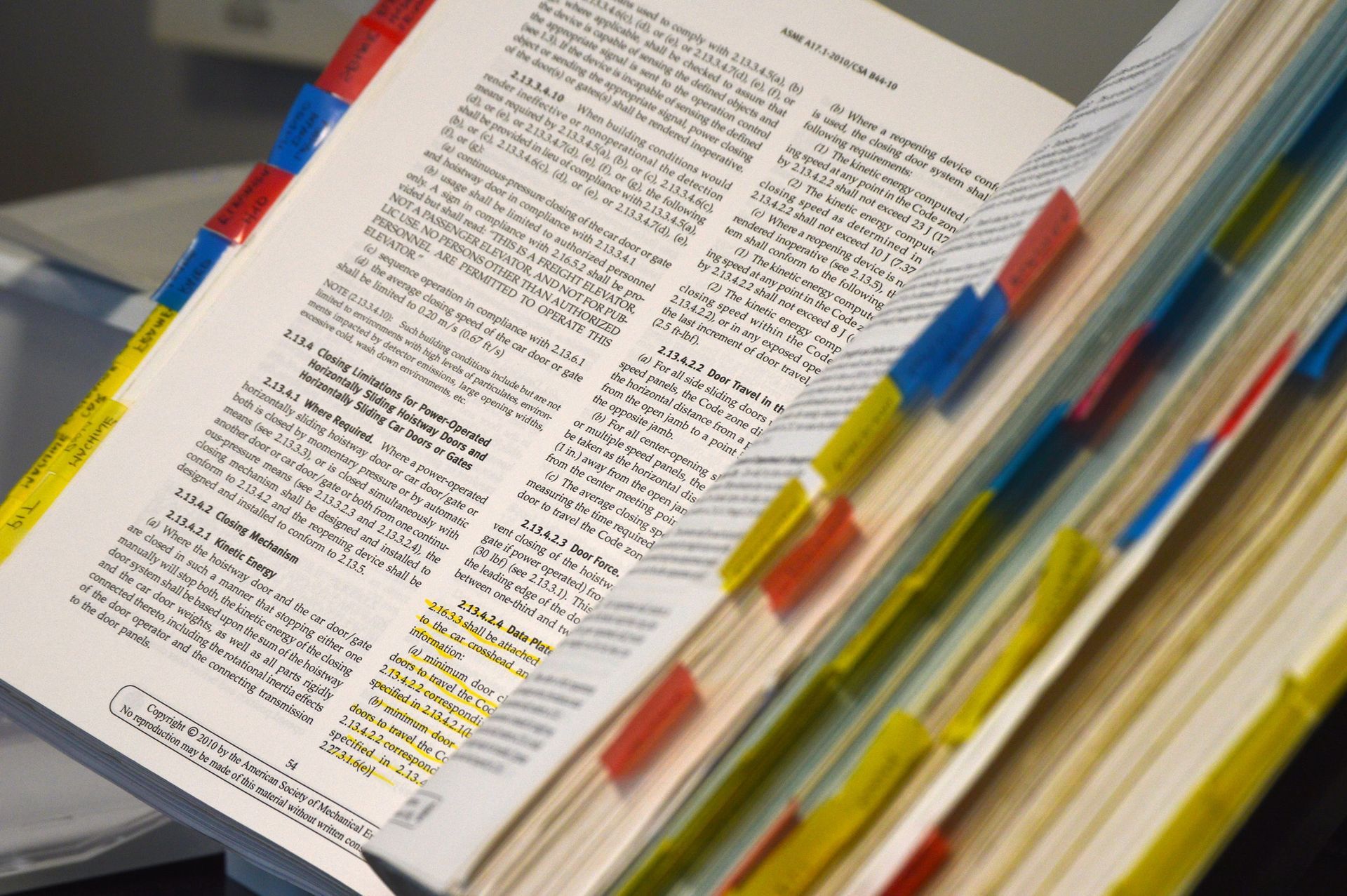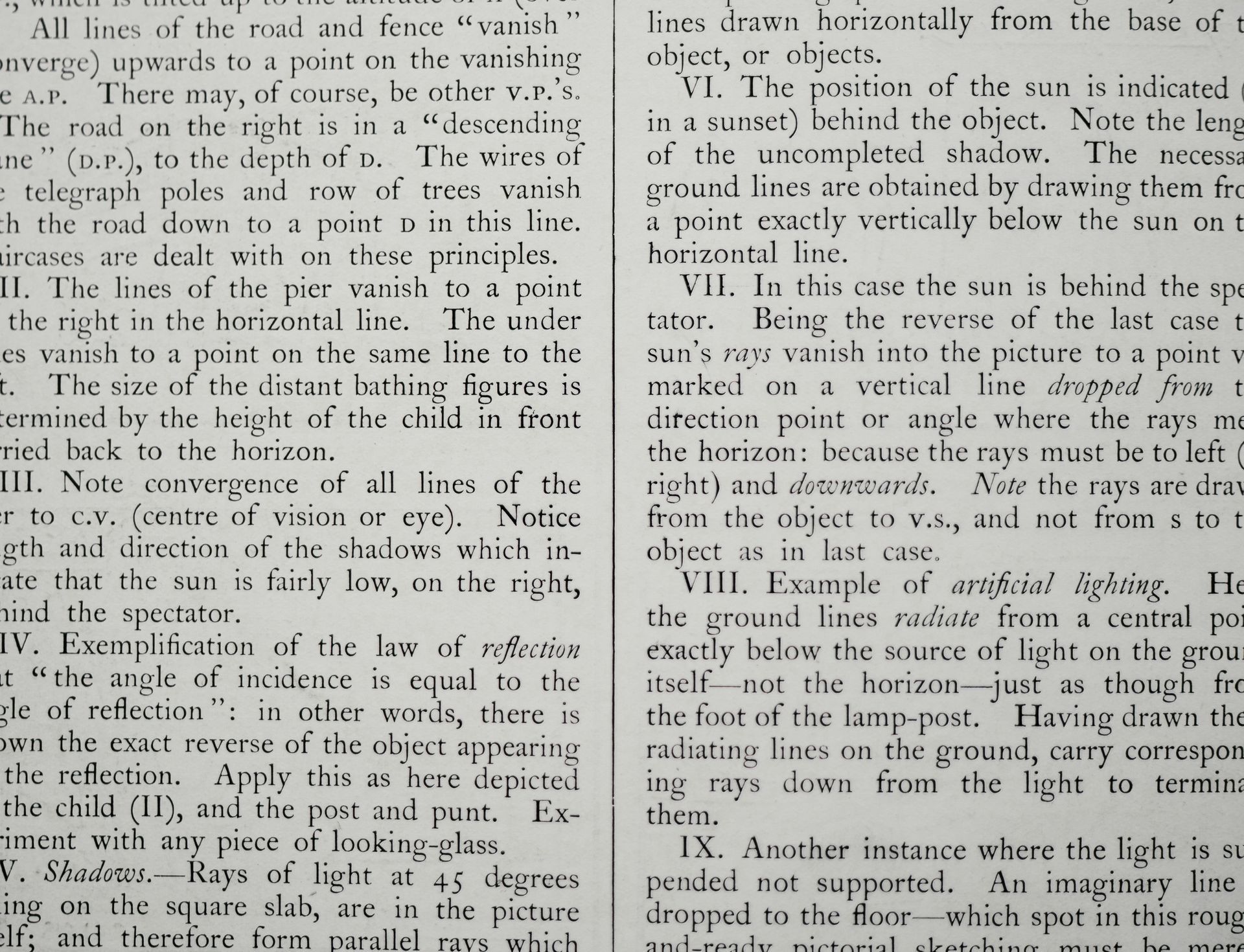Bid Management
The hub of co-ordination, you’re a systems thinker, a ‘people manager’ extraordinaire, and the one who keeps the wheels aligned and in motion at all times. You’re indispensable to the bid . . . and you recognise that within that indispensability is the responsibility for continuous improvement.
ACADEMY KNOWLEDGE BASE

By Jordan Kelly
•
March 2, 2025
Whilst the first and most immediately obvious step in improving poor articulation performance in a submission is to subject it to a rigorous editing process, there’s almost always a greater issue at play. That issue is the largely non-client-specific (at least, not convincingly specific) and generally “same, same” nature of the content . . . the supplier-focused “brochureware” that results from an unclear, uncertain or absent bid strategy. Or an insufficiently documented one. In almost every bidding enterprise I’ve worked with, writers have previously had to either rely on little more than workshop notes, together with existing generic content, to inform their response sections. For the most part, they’re forced to interpret and piece together in their own minds, the intended underpinning strategy and guiding themes supposedly resulting from planning sessions. In many cases, they’re faced with making up the content themselves without any guidance. It’s critical to recognise that producing a client-focused submission requires more than a simple emphasis on writing techniques and editing processes (e.g. flipping sentences around to commence with the client organisation’s name versus the bidder’s). If writers are given a comprehensive and user-friendly bid strategy blueprint to guide them, and along the way their outputs are nurtured by the appointed strategist within the group, their writing should, by default, adequately convey the bid strategy. And it should do so in a client-focused manner.

By Jordan Kelly
•
March 2, 2025
Have you ever had the demoralising experience of being engaged in a phone conversation with someone who suddenly starts shuffling papers, filing or (worse still) reading and responding to an unrelated email? If you were sufficiently forward as to protest and the other party sufficiently ignorant as to persist with his or her other activity, he or she would no doubt have given you the “I can multi-task” line. But I’ll wager it was obvious to you that, at best, your “multi-tasking” conversation partner was hearing only sporadic soundbytes of your end of the conversation. It’s a neurological fact that the brain can focus on only one matter at a time. It might flit between subjects, issues and conversations . . . but it can concentrate properly on only thing in any given moment. In his recent best-seller, ‘The Organized Mind’ , neuroscientist Daniel J. Levitin produces evidence to underscore how minimising the attention devoted to any one thing (the natural consequence of trying to spread one’s concentration amongst several things) dramatically decreases the quality of attention both to that and to everything else on that individual’s plate. Conversely, conceptual and critical thinking, along with insight and ingenuity, Levitin stresses, happen only when we screen out distractions and properly focus. Already, it’s pretty obvious how the nonsense practice of “multi-tasking” negatively impacts not only the quality of critical submissions, but every process that feeds into their production. As a bid strategist and coach, here are just two of the key processes that I regularly witness being adversely affected: Participants in strategy workshops insisting on reading and responding to emails and text messages . . . switching off to the thread of fast-moving, group conversations and thus forgo-ing their understanding of, and input into, the evolving bid strategy. Section authors and other writers interrupting their flow of writing inspiration to answer emails and their own incoming phone calls. (If professional authors feel the need to shut themselves away in order to place their full and uninterrupted focus on the piece they’re working on, why would someone who doesn’t write for a living feel they can produce a quality written output while “multi-tasking”?) Aligning with my cynicism over the concept of “multi-tasking” proficiency, Stanford University researchers have found that “multi-taskers” (a) have difficulty organising their thoughts and filtering out irrelevant information, and (b) are actually slower at them, with their switching from one task to another (versus those who stay focused on one activity until it is satisfactorily completed). Potentially, there’s also evidence that multi-tasking lowers one’s IQ. A University of London study found participants who multi-tasked during cognitive tasks experienced compromised IQ score declines similar to what might be expected had those individuals smoked marijuana or stayed up all night. Coming back to bidding. When you’re otherwise throwing everything at a must-win, high-stakes bid, why go at it with diffused mental energy? To do so argues with every claim you make – to yourself, to your bid team colleagues, and to the potential client – as to the importance of victory.

By Jordan Kelly
•
March 2, 2025
When you’re under the pump with a short submission timeframe, your best default strategy for getting a top-notch bid out the door in good time and with the least stress possible is to “go with the current” in terms of people’s natural talents. You can coach people in their areas of weakness to a reasonable degree, but rarely will they be great in those particular aspects of bid production. The fact is, people generally gravitate back to the aspects in which they naturally excel and endeavour to avoid those in which they don’t. And when a bid manager is under the pump, the cold, hard fact of the matter is that he or she simply doesn’t have the time to coach or cajole. Identify the Priority Skills Needed The first step is to accurately identify the priority skills required for each part of the submission and the process, giving careful consideration to which individuals possess these. It’s also smart to consider personality traits or work habits that stand to either propel or impede progress towards the finish line. Really think about each person and who (rather than what ) they are. ‘Day job’ position titles can be misleading in the context of a bid. Often, the strengths and weaknesses you’d assume of an individual in a particular role just don’t import across into a bid team environment in the way you’d expect them to. I’ll cite as a case study, a small, component operation of a larger organisation with which I had been working. One of the operation’s few "white collar" staff members (aside from the GM) was assigned as bid manager. It was a pressure cooker timeframe and, a few days after kick-off, the schedule was already floundering. In short, this assumedly "natural" bid manager appointment was a disastrous choice. As it happened, fate graciously stepped in and saw that individual suddenly pulled off onto another contract elsewhere. Because I was working with the team by remote control, there was little choice but for the Construction Manager to take over the bid management role. ‘Humble Hammer Swinger’ Saves the Day Fate dealt the bid a lucky hand that day. The previous appointee’s weakness was the Construction Manager’s strength. This "humble hammer swinger" (his own words) made a brilliant bid manager. He was organised, efficient, exercised total diligence in keeping his own commitments, and had an affable but effective way of holding others to their's. His humility came in handy, too: If he could see anything going off the rails, he was quick to pick up the phone for advice. The fact that he couldn’t string two coherent sentences together on paper turned out to be inconsequential. When the now-former bid manager returned to the team, he gravitated directly towards - and excelled at – the bid’s writing tasks, taking on those that had, in fact, been assigned to the Construction Manager. So, by complete accident, we ended up with a highly functional bid team and a top-notch bid out the door in what, for that particular operation, was apparently record time. To re-emphasise the moral of the story: When time is unavoidably tight, ensure the highest quality and the least stress by getting to know your "human resources" and letting each wear the cap that most comfortably fits him or her.

By Jordan Kelly
•
March 2, 2025
This article is a direct follow-on from, ‘The 11 Stages of Competent & Comprehensive Pre-Probity Bid Management’. Those stages that should be conducted post -release of the RFP are: Stage One : Hold a session to ‘reality check’ and finalise the Strategy Document against Expression of Interest or Request for Proposal content and requirements. It is critical that all participants undertake – prior to this session – their own personal, detailed reading of the market call documentation. Without this prior study of the document, the first few hours of the session will be soaked up by this exercise or - if the session proceeds without participants having read the EOI or RFP - the only contributors of value to the session will be those whom have read it. The purpose of the session is to complete and “reality check” the pre-probity-formulated interim strategy document against the client organisation’s actual information and requirements. Where significant additions or departures are identified, a revised Strategy Document must be issued. (It can reasonably be assumed that, most times, a revised Strategy Document will be necessary.) Stage Two : Submit the Bid Strategy Document to senior management for approval. This is a critical step in ensuring that the underlying strategy and the content of a proposed end submission is not rejected, by senior executives, at the eleventh hour. Stage Three : Confirm or modify brief to designers based on above. With reference to Stage 11: Formulate brief for designers (see ‘The 11 Stages of Competent & Comprehensive Pre-Probity Bid Management '', this earlier “heads up” preparatory brief should now be revised/refined/supplemented and formalised). Stage Four : The Strategy Document should be issued to authors, and a writing coaching session should be held for those authors (including subject matter experts) contributing to each submission section. A bid-specific coaching session is a valuable exercise, to identify the degree of writing competence possessed by each contributor and apportion any assistance resources early and appropriately. Stage Five : Early-Stage Review. The Bid Strategist, along with whomever the Bid Manager has appointed as the editor of the end submission, should review each contributor’s first few paragraphs / first page, to determine whether he or she is “on the right track” with his or her copy. This allows for the provision of direction and any material input in the early stages, as opposed to the latter stages (which creates editing and re-writing bottlenecks dangerously close to the submission deadline). Stage Six : Strategic diagrammatic support identified and briefs given. Opportunities to support/supplement the written content with diagrammatic and other visual content should be identified, and the relevant subject matter experts pulled in to brief the design team (to whom preliminary relevant copy sections should be provided). Stage Seven : Subsequent series of reviews. Upload of first and subsequent drafts (allow for at least five ) by the date identified jointly by the Bid Strategist, Bid Manager and editor. The number and timeframes for these reviews should be realistic to accommodate the number of Bid Manager/author exchanges that will be necessary to bring copy to Final. Take into consideration that: a) Where contributors are not professional writers, considerable redrafting and/or editing will likely be necessary. b) Where professional writers are producing the content, these writers are unlikely to also be subject matter experts, and revisions to the substance and detail of their copy will likely be necessary when reviewed by the topic experts. c) Diagrammatic and other visual supplementation should be submitted back to the subject matter experts who briefed the design team. As above, this must be done with plenty of time to allow for several rounds of correctional iterations. Stage Eight : The Bid Manager should make a final review of content prior to tabling to the Pursuit Leader and Bid Strategist. The Bid Manager must ensure the draft submission is technologically sound, as well as comprehensive, in terms of strategy. If there are significant shortfalls in these areas, the Bid Manager should return the copy to the author for correction and/or completion. It should then be submitted back to the Bid Manager by the author. After the Bid Manager is satisfied with the soundness and comprehensiveness of the draft in question, the Pursuit Leader and Bid Strategist should be brought back into the review process. For quality control and consistency purposes, all copy (e.g. case studies, CVs, appendices) – within reason – should be reviewed by the Pursuit Leader and the Bid Strategist. Stage Nine : Production of Executive Summary (i.e. towards end of above process, when a more detailed and authoritative picture of the content is known). Writing a submission’s Executive Summary before the production of the bulk of its content, is illogical. An Executive Summary should be precisely that i.e. a Summary . Unfortunately, many (if not, most) bidders treat this as either a covering letter or a preamble sales piece. Stage Ten : Graphic production and checking. Review of the various iterations of the graphic design should follow the same basic procedural format as for the review of the written content. Stage Eleven : Senior management review/comment. The bid strategy document should be provided to any reviewing senior management who were not privy to it in the earlier stages, and in plenty of time for each to have read and absorbed it before receiving the proposed end submission for approval. Meantime, as a refresher, a summarised, key point version of the strategy document should be provided to those whom have already been provided with the fuller version. Stage Twelve : Final adjustment and editing to professionally blend in management additions and alterations. Do not underestimate the potential volume of revisions, additions and subtractions senior management has a propensity to request – especially if the bid involves joint venture partners and, thus, executives from several organisations (who may not be in agreement with each other on matters of detail). Stage Thirteen : Insertion of copy into page design framework. The Pursuit Leader, Bid Strategist and Bid Manager overview the intended final design production, quality-control-checking at the very finest level of detail, before delivery to prospective client organisation. See: ‘The 11 Stages of Competent & Comprehensive Pre-Probity Bid Management’ .

By Jordan Kelly
•
February 24, 2025
If – as pursuit leader or bid strategist – you haven’t checked off the following key preparatory measures before your bid writers put fingers to keyboard, you greatly risk falling into the standard default position i.e. section authors producing thinly-disguised "brochureware", and others producing what comes across as cut-and-pastes from a product or procedures manual. So ensure you can answer fully in the affirmative before you set your section authors loose on their tasks: Have you produced a comprehensive, high-readability, overarching strategy document? Have you produced writer’s guides – based on the above – for each major section or Schedule? Before finalising the above, have you shown these to several of the writers to ensure they are user-friendly from their perspective? Have you held a collective briefing session i.e. between the strategist, one or two other key participants in the strategy workshops, and the section authors i.e. to verbally explain the strategy and how it underpins or influences their sections? Have you returned to each section author, individually, following this initial collective briefing, to ensure they understand and can follow their respective writing guide? And that they have aligned the content of their writing guide with their section content plan? Does any section author feel he or she needs more supporting information that they need help to obtain? These are the key steps to ensuring bid content that reflects, and adheres to, a central, cohesive, underpinning strategy.

By Jordan Kelly
•
February 23, 2025
The tone or writing style of a bid need not be 100 percent uniform across all sections of the submission, but an editor should ensure against a mish-mash of different, non-complementary styles. A bid with a “salesy” Executive Summary or “front end”, and a “back end” that ranges widely from misplaced “brochureware” to dry academia, gives the impression of a disorganised vendor or bidder. Depending on the degree of disparity, it could even convey the impression that the various departments within the bidding enterprise are not on the same page. In answer to the question, “What’s the best style of writing to employ in a bid?” , it would be simple to say, “That which comes naturally to the writer.” Unfortunately, it would also be simplistic. The problem is, sometimes (often, in fact), a stilted, convoluted academic style is the section contributor’s default writing style. A partial answer to this – and one which avoids this pot pourri of styles ending up on the editor’s desk in the first place – is to coach all section authors in the use of the active voice in their writing.

By Jordan Kelly
•
February 21, 2025
Here are the first five of the 10 mistakes that I have most frequently, across the course of my 12 years as a bid strategist and writer, witnessed bid teams making. Each one of these practices is, in its own right, damaging to a bid’s success. Collectively, however, they as good as guarantee that the […]

By Jordan Kelly
•
February 20, 2025
This advice is for those contributing content to a tender / proposal / bid or other form of submission, but who don’t write as a “day job”. It’s too easy, and sometimes automatic, for subject matter experts or other “non-writers” to come to a bid-writing task with the mindset that, “No-one can expect too much from me; I’m not a professional writer.” But that attitude both limits your thinking and your confidence and stymies your standards. Instead, try moving all the way to the opposite end of the spectrum: Write as though the whole world is going to read and savour every word you write, contemplate the sentiments underlying it and the strategy informing your piece, and be influenced to move by its convictions and the propositions it puts forward. In 2000, Stephen King detoured briefly but potently into non-fiction, with the publication of his ‘ On Writing: A Memoir of the Craft’ part-autobiography, part-guide book both for established writers and would-be writers. In it, he explains his own attitude towards the written word: “You can approach the act of writing with nervousness, excitement, hopefulness, or even despair – the sense that you can never completely put on the page what’s in your mind and heart. “You can come to the act with your fists clenched and your eyes narrowed, ready to kick ass and take down names. You can come to it because you want a girl to marry you or because you want to change the world. “Come to it any way but lightly. Let me say it again: you must not come lightly to the blank page.” – Stephen King, ‘On Writing: A Memoir of the Craft’ What if you were to take King’s recommended approach to those written pieces you’ve been tasked with contributing to the bid team’s submission? Would it make a difference? Writer’s Block Perhaps you struggle with “writer’s block”? See ‘ How to Beat Writer’s Block’ . Just start. Somewhere. You can always go back and write skipped elements (even the introductory paragraphs) or re-write. And by the time you head back there, you’ll likely be on a roll. What if your problem is simply discomfort with the whole process of writing? King has the answer for that: Read copiously. “If you don’t have time to read, you don’t have the time (or the tools) to write. Simple as that.” Write something every day, just for the sake of writing deliberately and with focus. King himself writes at least 10 pages a day including Christmas, Independence Day, and his birthday. When the Going Gets Tough – Push Through And finally, don’t give up when the going gets hard: King wrote the 1974 blockbuster ‘Carrie’ , his first published book, while living in a caravan or – in North American terminology – a “double wide trailer”. Frustrated when he hit creativity Roadblocks, he threw the manuscript in his wastepaper basket. Later, his wife discovered it there, pulled it out, uncrumpled it, and read it. The rest is history. As he points out in ‘On Writing’ , “stopping a piece of work just because it’s hard . . . is a bad idea.”

By Jordan Kelly
•
February 18, 2025
The best-quality submissions have one thing in common: research and other forms of preparation start early . . . long before the formal Expression of Interest or Request for Proposal is released into the marketplace. Conversely, inadequate pre-probity preparation sets the scene for a submission characterised by rushed background research (if any), as well as the disorganisation that results from waiting until the client’s always-too-short deadline is upon the bidder. The following is a set of recommendations for the research and preparation an intending bidder should conduct prior to the client’s release of the formal market call documentation. I have developed, tested and consistently employed this series of pre-probity bid management steps over the course of the past dozen years. It’s been refined now to the point where it represents a logical, comprehensive, streamlined framework – and ensures a strategy-based, high quality end-submission. Stage One : Collation and sharing of the existing information resulting from all previous prospect/client meetings and communications. Prior to the conduct of any bid strategy formulation sessions, all information gathered by business development personnel needs to be corralled, co-ordinated, verified and expanded upon. Stage Two : Initial overview strategy session with management personnel responsible for selecting external partners and bid team members. It’s critical to identify the most likely core elements of your intended approach (notwithstanding that this can, at this stage, be based only on pre-release research, communications and assumptions) before the selection of bid team participants and contributors, and before the selection of any joint venture partners, in order to ensure the assembled team is relevant to that strategy . Stage Three : Identify external partners and team management. Logical follow-on from Stage Three. Stage Four : Strategy session/s to map out an interim/likely strategy. The Pursuit Leader / Business Development operatives, Bid Strategist and Bid Manager should work closely together to identify the most strategic participants for this early and initial (pre-release) bid strategy development session (or series of sessions). The invitee list should focus tightly on those with direct client and project/contract experience , and relevant competitor knowledge , in order to ensure those participating have a valuable and specific contribution to make to the strategy development process. Stage Five : Production of a formal Interim Bid Strategy Document. This forms an early blueprint for the approach to the EOI/RFP response. It also documents a clear “to do list”, to ensure identified knowledge gaps are filled. (It needs to be recognised that although this will be based on the best information available at the time, it will be subject to any degree of change both before and after the client’s market call documentation is released.) Stage Six : Follow-through of Interim Strategy Document recommendations. The Pursuit Leader and his or her team, the Bid Strategist, and the Bid Manager must work closely together in the collection of additional information and actioning of items directed by the Interim Strategy document. This stage should include the identification of any Subject Matter Experts (SMEs) whose input may be required into any sub-strategies (flagged by the Interim Strategy document) for development. Stage Seven : Team education. The opportunity exists – while Stage Six is being conducted – to assess the broader team’s (a) project knowledge base, and (b) relevant writing competencies, and to address these issues prior to the bid production phase. Stage Eight : Second strategy session and production of "anticipated final" Strategy Document. The purpose of the second series of strategy sessions is to bring together the further information requested by the Interim Strategy document, firm up sub-strategies, and work with this new/refined input to develop the anticipated final strategy. (Clearly, if the directives of the Interim Strategy Document have not been actioned, the value of outputs from these second sessions will be negatively impacted.) This document will then form the final bid strategy blueprint, subject to its testing against the content and requirements of the actual RFP, upon release. Stage Nine : Customising of case studies and Curricula Vitae. The bid strategy blueprint in hand, an immediate start can now be made on the production of customised case studies / project data sheets, contract/project-specific CVs, along with any other supporting documentation likely to be required as part of the submission. Stage Ten : Testimonial-gathering, in accordance with Strategy Document intentions and directions. Similarly to Stage Nine, high-value testimonials should be sought from the most relevant of the bidder’s clients/customers. Stage 11 : Formulate brief for designers. As a “heads up”, if the submission will be heavy in volume, a specifically-formulated written design brief – the essence of which is distilled from the Strategy Document – should be produced for design / production personnel. This should be supplemented by an oral presentation of the essential elements of the bid strategy. Lengthy experience working directly with designers over many years has shown that the delivery of a clear, detailed and definitive design brief is essential to the design team’s development of a competent and strategic design concept proposal.

By Jordan Kelly
•
February 12, 2025
Where a bid team operates with at least a moderate sense of urgency from the outset, this (generally) eliminates the need to enter into panic mode in the bid’s closing stages. In my experience, there is a direct correlation between the sense of urgency attributed to the early stages of a submission process, and the stress either experienced or avoided in its final stages. Where the bulk of the writing and production activity is compressed into the latter stages of the bid process – lack of control, un-exercised opportunities, inaccuracies and a general lack of quality control result. Keep It Moving It’s important to keep all components of the overall bid production process continually moving, as any singular point of unnecessary delay e.g. in the completion of the strategy workshops, in the production of the strategy blueprint, or in the individual section authors’ camps can result in a collective bottleneck. Bottlenecks also occur within each process area itself. For example, if you’ve scheduled the editing process such that the various section authors’ contributions arrive in for editing in a neatly staggered manner, but some of the writers miss their deadlines, you’ll end up with a jam-up on the editor’s desk. An early and consistent sense of urgency allows for a more realistic number of editing rounds (and re-writes, which are necessary in the majority of cases), along with a macro-level, across-the-submission edit, to ensure the response reads as one cohesive, flowing and comprehensive document. Bids, Stress & Sustainability There’s another reason to avoid the common scene at the end of the submission timeframe. For most large B2B and B2G organisations, major bids are not one-off or sporadic events. They’re a back-to-back, year-around way of life. In many cases, developing this early start / moderate sense of urgency approach to submissions helps ensure personnel get to operate in a physically and psychologically sustainable manner. See the following articles, also in the Bid Management section of Pursuits Academy: ‘The 11 Stages of Competent & Comprehensive Pre-Probity Bid Management’ ‘The 13 Stages of Competent & Comprehensive Post-EOI/RFP/RFT-Release Bid Management’ ‘Set Priorities & Nail Them One At A Time’

By Jordan Kelly
•
February 11, 2025
Always edit your work before handing it over to the bid manager, regardless of whether or not it will be the subject of further treatment by another writer or an editor. Here are some questions to ask yourself: Is my introductory paragraph compelling? Have I proceeded to the main point/s as quickly as possible? Have I established credibility on behalf of my company, where this is necessary? Have I answered the question – directly, and in the required amount of detail? Have I provided data and any other form of proof point necessary, with regard to any claim I have made? Have I been clear in terms of the key messages I intended to communicate? Have I framed the material from the client’s point of interest – in all regards? Have I adhered closely to the themes, content and instructions of the guiding bid strategy document? Have I employed these in a manner that helps to differentiate my company and our offering from the competition’s likely proposition? Have I focused on communicating benefits; not just features? Are my sentences and paragraphs of a reasonable (and preferably, a varied) length? Are my sentences complete? Have I ended paragraphs and started new ones according to a clear progression of logic in my material? Have I been clear and concise? Can I cut out any unnecessary words? Have I written to express, rather than to impress? Have I avoided flowery and/or fashionable language? Are all my facts relevant? Have I explained any facts and observations that, from the evaluator’s perspective, require it? Have I checked my copy for spelling and grammatical errors (particularly those I know I commonly make)? Have I avoided the over-use of industry jargon? Have I explained any jargon, where it won’t be familiar to the evaluator? Have I avoided the use of my company’s own internal-speak and other terminology that the evaluator may not fully understand, and therefore may have to guess at? Have I read my copy allowed to a disinterested party, to experience the valuable phenomenon of “hearing it through another’s ears”?

By Jordan Kelly
•
February 6, 2025
In ‘ Grammar Gaffes to Avoid In Bids ', I rolled out a list of common grammatical malfunctions I see in bid submissions. It’s now clear that people at all levels within their respective organisations share my concern about the credibility-denting effect of poor grammar. What’s also become particularly clear is that there’s a real irritation over the lack of basic grammatical knowledge by a significant proportion of the younger generation . . . you know, those for whom “texting” probably came before any real study of the English language and how to use it correctly. That said, it’s probably my own generation that has the greater culpability in the matter, given that it’s my generation that should have taught them better. But, to leave the greater blame discussion for another forum, when personnel from the Millennial generation are tasked with contributing to submissions – believe it or not – I’m seeing some truly horrifying examples of poor schooling. Some examples for you. Writers who don’t know when to correctly use the word “than” , as opposed to “then” . . . as in: ( WRONG) “Should this occur, than we will implement the following contingency plan.” ( ALSO WRONG) “Our experience demonstrates this course of action is more effective then conventional responses.” Writers who don’t know the difference between “your” and “you’re” (notwithstanding the fact that the contraction “you’re” has no place in bid writing) as in: (WRONG) “We have given careful consideration to the issues your currently experiencing as regards consumables recycling.” (ALSO WRONG) “ You’re systems will be monitored on a weekly basis.” Writers who seem to think commas have replaced the traditional use of the full stop (and, worse still, that it serves no other function): (WRONG) “This is a current area of focus for our organisation, we are deeply concerned about the impact upon local waterways.” Writers who have never heard of the hyphen . . . as in: ( WRONG) ” . . . a 25 year old piece of equipment” . . . ” (as opposed to i.e. CORRECT ) “a 25-year-old piece of equipment”). ( WRONG) “A to be advised date", as opposed to ( CORRECT ) “a to-be-advised date.” Or, worse still, clumsy, un-hyphenated conglomerations like (WRONG) “ proAustralian “, and (WRONG) “ semidetachable ” versus (CORRECT) “ pro-Australian ” and (CORRECT) “ semi-detachable .” Writers who see no difference in their application of “ there ”, “ they’re ”, and “ their ”, or “ whose ” and “ who’s “. The Disappearing Question Mark My other beef with younger writers is their propensity to see question marks as unnecessary. Where did this notion come from? Perhaps they feel that avoiding the use of a question mark (where one is, in fact, necessary) makes their writing read more authoritatively. Who knows? Whatever their reasoning, such a practice is grammatically incorrect. A question is a question and should be denoted as such with a concluding question mark. Ironically, it seems just as many of these same young writers employ question marks when it is grammatically incorrect to do so: (WRONG) “He asked what their labour turnover was? ” This question is indirect and does not require a question mark. This is not, however, to be confused with the fact that a question mark is used to indicate a reflective question (although these instances occur primarily in spoken English: “You were showing a profit up until then?” ) So . . . let me have it. Am I just a grumpy grammar curmudgeon? Or do you share / continue to share my concern – and have a few of your own personal non-favourites to share with me?

By Jordan Kelly
•
February 5, 2025
When preparing to send your section authors and subject matter experts off to begin their respective writing tasks, check and ensure the following: Whether a seasoned bid writer or a newbie, check that each has planned out his or her sections out before embarking on each section. That each has adhered to the plan you overviewed with him or her for the content of his or her section. That each has checked his or her “facts”. That each has substantiated any claim he or she has made. That each has made his or her first paragraph – as the “introduction” to their piece – strong and punchy, and that this “intro” paragraph provides a compelling entry point to the rest of his or her section. That each has drawn out the project-specific or contract-specific relevance and meaning of anything they have written. They should be aiming to do as much of the evaluators’ thinking for them, as possible. That each has communicated the benefits associated with the features of the technology or service ( not just the features). As you conduct these initial and progressive checks, assemble for yourself a helicopter view as to how consistently and seamlessly the various sections fit together (or not), and whether they are all in the same degree of alignment with the overarching bid strategy guidance document.

By Jordan Kelly
•
February 4, 2025
If you’re looking for "high-viz" points of difference when competing with larger competitors, look no further than the avoidance of convoluted bombast and meaningless "mumph" as your first. Most corporate submissions are full of it. The use of plain, unadulterated English will be a refreshing change for your prospect organisation’s evaluators. Bid teams cause themselves a huge problem when they insist on using trendy fashion-speak and other frivolous fuzz in their written responses. Knowing the frustration this causes clients, and the frequency with which it happens, I can only sincerely urge you to take full advantage of the likelihood of any tendency by your competitors towards what is “high-falutin'” verbiage. There are two key reasons your competitors engage in this rubbishy writing. More often than not, its usage is an attempt to sound sophisticated and “switched on” or “up to the minute”. Other times it’s to smoke over a lack of substance in answers to the bid documentation’s questions. Often, it’s both. Bid teams and their writers can also get tangled up in this type of non-English even when there actually is knowledge and potential substance to be conveyed in the content of a proposal or bid. This is particularly unfortunate for their employers (but equally to your advantage), because those documents come across pretty much the same as the substance-less version that uses the same type of guff to disguise a lack of core message. Here are some examples of this sort of “empty’” writing. These examples are fabricated because quite clearly I can’t refer to confidential bid documents. Nonetheless, they’re typical of some of the writing I see produced by corporate sales and bid teams . . . and many senior executives, too, even more alarmingly. Example 1: We employ best-of-breed technology options to implement cutting-edge, proven solutions, ensuring you of a constantly innovative approach and continuous improvement in your IT environment. Example 2: Our track record demonstrates our commitment to world best practice and, accordingly, we will engage our focus on innovation throughout the contract. Example 3: As your business partner, we will work closely with you to leverage our experience across the project, producing an optimal solution that is robust, scalable and that can be seamlessly integrated with your existing systems. Do experienced operatives really write this kind of largely meaningless nonsense ? Yes, they do. And much worse. The entire content of some of the bids I’m given to provide commentary on is as convoluted and meaningless as the above examples. Tens (sometimes hundreds) of pages of, largely, non-information. This commonly happens when little or no prior planning takes place and where, as a result, there is no central bid strategy. Worse still, this strategy-less starting point guarantees a very supplier-centric bid or proposal. And usually one that is not even particularly readable or sensible, let alone compelling. My recommendations are two-fold: • Use plain English. Resist the temptation to dazzle the prospective customer or client organisation and its evaluators with an extensive array of jargon. I’m always particularly saddened when I see a submission produced by a smaller enterprise, the management of which obviously thinks it’s a demonstration of their ability to foot it against their larger competitors by using the same crazy corporate-speak. • Place priority emphasis (as early as possible) on conducting intensive, thorough bid strategy planning sessions (preceded by comprehensive client, contract/project and competitor research). This will help ensure a distinctive win theme and, in turn, solid content - and applies to any size business. Tell it like it is. Drop the dandy words. You don’t need them, the client/prospect and its evaluators are neither fooled nor impressed by them – and (pending the quality of your offer and the substance of your content) the absence of them will render your documentation a pure and softly-landing snowflake amidst the garbage that is the hard-going reading contained in your corporate competitors’ productions.

By Jordan Kelly
•
February 4, 2025
Here are some examples of particularly regrettable grammatical gaffes found in bid documentation: ‘Then’ Instead of ‘Than’ Unbelievably, some writers don’t know when to correctly use the word “than”, as opposed to “then” . . . as in: “Should this occur, than (i.e. s hould be “then”) we will implement the following contingency plan. Our experience demonstrates this course of action is more effective then (i.e. should be “than”) conventional responses.” ‘Your’ and ‘You’re’ Some writers don’t know the difference between “your” and “you’re” . . . (notwithstanding the fact that the contraction “you’re” has no place in bid writing) as in: “We have given careful consideration to the issues your (i.e. should be “you’re”) currently experiencing as regards consumables recycling. You’re (i.e. should be “your”) systems will be monitored on a weekly basis.” Full Stops and Commas And then there are writers who seem to think commas have replaced the traditional use of the full stop (and, worse still, that it serves no other function) . . . as in: “This is a current area of focus for our organisation, we are deeply concerned about the impact upon local waterways.” And there are writers who have never heard of the hyphen . . . as in: "A 25 year old piece of equipment (which should be) a 25-year-old piece of equipment" "A to be advised date to-be-advised date (which should be) a to-be-advised date" Or, worse still, writers who use clumsy and un-hyphenated conglomerations like: proAustralian (which should be) pro-Australian semidetachable (which should be) semi-detachable It looks horrid. It reads horrid. And it makes a horrid impression with Expression of Interest and Request for Proposal evaluators who value correct English and grammar.

By Jordan Kelly
•
January 31, 2025
With grammatical standards slipping badly in today’s digital/electronic communications-driven society, there’s been an unfortunate flow-on effect in the quality of written presentation in bids i.e. responses to Expressions of Interest (EOIs), Requests for Tender (RFTs), Requests for Proposal (RFPs), and the like. Many years ago, when I was a fresh-from-high-school cadet reporter, my subeditor (the unsmiling, could-never-be-pleased 6’4″ ”Mr G”) forged my fledgling news-writing and editorial standards by constantly drumming into me: “Make your writing understandable to the lowest common denominator within the readership. Make your grammar acceptable to the highest common denominator.” I write frequently on the first part of the fearsome Mr G’s admonition. However, writing – as I do – for a predominantly mid to senior level audience, I rarely write in regard to the second part of the admonition. But now, with the rapidly declining standards I’m observing both in everyday corporate communications and in bid-related documentation, it’s time to bring the issue out of the closet. Before I do, let me make this point: For every section author or subject matter contributor that considers this degree of concern reflective of “anal retentiveness”, there’s a reader (and possibly a multiple thereof) that considers the correct use of grammar reflective of a basic fifth grade education. Which of these two opposing viewpoints do you think is most likely to be represented on evaluation and supplier selection committees in the case of high-value bids? I sincerely hope you answered in favour of the latter (age factors alone would suggest this). This, then, is your “highest common denominator” reader . . . and his or her opinion of your organisation’s grammatical standards stands to directly flavour the credibility he or she attaches to your submission. Subconscious Judgements Aplenty At the most basic and overt level, a bid writer’s incorrect use of grammar might render some aspects of your EOI or RFP response, or your proposal, ambiguous or otherwise unclear to an evaluation team. At the more subconscious level, it’s possible the evaluators could make an unfavourable judgement about your organisation’s propensity for attention to detail in its service delivery or other aspects of its after-sales performance (including communication). If so, they could be forming a hard-to-change opinion about the frustration your people are likely to visit upon their people in your organisation’s ongoing relationship with them. And somewhere towards the centre of the spectrum of concern is the certainty that the evaluation panel will be questioning the overall professionalism of your enterprise in general. And all for the want of the exercise of leadership in your standards of written communication. So, is it worth taking a stand against today’s trend towards the relaxation of conventional grammatical standards? Is it worth demonstrating leadership in this regard? And, if so, is it worth making certain these high standards are firmly evidenced by the quality of your bid, tender and proposal documentation? I vote “YES”. (Mr G may be watching.) How do you vote?

By Jordan Kelly
•
January 29, 2025
In Part One of this article, I shared my knowledge of the habits of writers who achieve ‘super-human’ levels of productivity. I also shared the modus operandi that enabled me to push out 17 books in three years, while keeping on top of my daily consulting and coaching commitments. I trust the first three insights […]

By Jordan Kelly
•
January 28, 2025
Tardiness leaves our credibility and even our honesty open to question. Conducting a pre-submission review for a client recently, I noted a claim that two delivery team members had “a collective 50 years’ experience” in a particular type of infrastructure. However, this didn’t tally with the individuals’ Curricula Vitae, so I asked for these figures to be checked. The amended figure came back: “30 years of collective experience”. The client notices these inconsistencies , and a figure pulled out of the air doesn’t do our credibility any good. At all.

By Jordan Kelly
•
January 27, 2025
Start your shortlistee presentation preparation checklist with the following basics: Is everybody versed in how to get to the venue, travel times and contingency considerations e.g. traffic issues? What is the process or expected norm for introductions (a) upon arrival, and (b) preceding the actual presentation? What equipment is available? Are our presentation tools compatible? What additional, non-technology, equipment do we need, and who will provide this? If the client will provide this, is what’s in their mind the same thing as what’s in our mind? Check that what we call certain items and tools is the same as they call them. What’s the policy on hand-outs? Is the time allocation loose or concrete? Have we timed ourselves? What’s the Q&A protocol? Do we have everyone on board to attend that might be needed in a Q&A situation? How will we be expected to wrap up?

By Jordan Kelly
•
January 22, 2025
Skimp on the detail in the first three stages of the bidding process and your chances of winning a mission-critical bid are severely compromised from the outset. On the flip side, do an outstanding job of laying these foundations, and you’ve given yourself a giant head start on any competitors that haven’t (and most don’t). 1. Conduct the most comprehensive, self-critical "bid or no bid" analysis possible. A competent and comprehensive “bid vs no bid analysis” gets you clear on every component of your motivation for bidding the project or contract in question. But that’s not all it achieves. It also lays the groundwork for the later formulation of your bid strategy, by identifying each individual point of alignment between the client’s objectives, challenges and concerns, and your enterprise’s capabilities. This gives you a head start on solidifying these and making them even more relevant to the client and its likely selection criteria. Equally, it helps you identify the points of misalignment; the areas in which a better-positioned competitor can undermine you . . . and gives you the earliest possible chance to address these. 2. Select your bid team members strategically. It’s a sad fact that, often – especially when a bidder has multiple Expression of Interest (EOI) and Request for Proposal (RFP) responses on the go – the bulk of the bid team is simply an assembly of the available, with a couple of relevant subject matter experts thrown in. There’s also scant attention paid to the probable dynamics within the team – and whether these are likely to result in a streamlined, highly productive process, or a frustrating, unhappy experience and a likely compromised output. The inputs and outputs of a bid team can only ever be as good as the research, care and strategy that went into the selection of the individuals it comprises. And, also of the way in which those individuals work together to enhance the performance of that collective. 3. Optimise every opportunity in the pre-probity phase. From the analysis of research requirements (both known and not yet known), to the identification both of primary and secondary sources, to the meticulous planning of the information collection activities, to the verification of resultant inputs, through to the conversion of raw information to high-value intelligence – and every minor stage in between – your bid strategy will fail or fly based on your diligence in this phase.

By Jordan Kelly
•
January 10, 2025
Here are the core tenets of good bid management. Bid management, that is, that eliminates to the greatest degree possible, health-compromising stress from the bidding process. (More on that in a future article.) They include but (arguably) are certainly not limited to: 1) The clear and careful assessment of the advisability of pursuing the business in the first place. Proceeding with a bid you’re not qualified for, not prepared for – or that you shouldn’t go for, for some other reason – is setting yourself up for huge stress and no pay-off. I’ve seen numerous companies insist on investing huge resources in a bid they didn’t have a chance of winning. Their pre-sales engagement was inadequate (or non-existent). Their insider knowledge of the prospect organisation was insufficient. They had no idea of the competition’s standing with the prospect. And management couldn’t even truthfully say it believed the company could do the best job for the client in question. Be realistic. 2) Ensuring an early start. A very early start. Steal the lead on your competitors. Give yourself ample time – and then some – to explore all avenues of research – both primary and secondary / direct and indirect. There are some industries in which, if a bidder hasn’t researched the contract/project, the client organisation and the political backdrop in detail at least six months before the release of the Request for Proposal, that bidder is massively behind the eight-ball . . . and should seriously consider the wisdom of proceeding. Certainly, once the client’s tender documentation is released to market and the probity curtain comes down, a bidder has lost all real opportunity in terms of any information still to be gleaned from the client or associated parties. That is, unless that bidder is happy for its potential strategy to be flagged to competitors when its questions are published on the relevant pages of the client’s website for all to read – along with the client’s answers. (Not that that’s the forum for asking anything deep and meaningful, anyway.) 3) Undertaking a comprehensive recap of the debrief associated with the bidder’s most similar, recent EOI / RFP / RFT responses – along with any that may have been submitted to the client in question at any point. Learning from your mistakes is one of the best ways to ensure against a repeat performance. 4) Adequate time devoted to pre-bid strategy sessions. Bidders that whip through these sessions, with silly little 45-minute segments for critical investigations such as competitor analysis, are either naïve, arrogant or both. Probably both. (It’s a great way to give your competitors the advantage, though.) 5) Careful advance consideration of the broad topic areas requiring coverage in strategy workshops, and placement of the right people in the room (and all of the right people). If you don’t have the right knowledge sources at your bid strategy planning sessions, you’ll either end up with an uninformed (or worse, a misinformed) strategy, or you’ll have to run additional sessions. And there goes your production schedule, right there. 6) The running of a tight ship at planning sessions. If a bid leader or bid manager caves into the insistence that bid team members can’t survive an eight-hour workshop without their mobiles and their laptops, they deserve the lack of attention that is absolutely 100 percent guaranteed to result. Similarly, if they allow people to wander in and out of the room at will and cruise back from breaks as they please. At least consider those members of the team who are treating the exercise seriously and respect their commitment by ensuring that others don’t compromise the quantity and quality of the session’s outputs. Insufficient and poor quality outputs = poor quality strategy = poor quality content = bid manager running around like a headless chook at the end of the production schedule trying to make a silk purse out of a sow’s ear. 7) Adherence to schedule in the writing phase through reliance upon a well-researched, well-considered, comprehensive strategy blueprint. Similarly to the above point, one of the primary reasons for the stressed condition of those responsible for chiseling the final production into shape, is that they are faced with a strategy-less and waffly piece of “brochureware”, in place of (what should have been) well-thought-out, well-guided, co-ordinated, comprehensively and accurately answered written response sections. 8) Putting the right people onto the right job. In Think & Win Bids , I write about the four “MOs” (Modus Operandi) or operating style categories that I observe bid team members falling into. There are some “MOs” you simply wouldn’t assign with a certain task if you want the job done with any deal of competence and enthusiasm, and there are others who will relish the very same assignment. There are others who will fall down the rabbit hole and forget how to get back up it, and others who know how to shoot a straight arrow at the same target. And yet others who will do a great job if you need something fast and you’re OK with “shallow” as a trade-off, and others who’ll excel at hard, deep research – but you can forget “fast”. A sharp bid manager will identify and capitalise on the natural strengths of his or her people to ensure the bid stays on schedule, and that a quality output is evolving. 9) Shunning the ‘war room’ concept. If you’ve been following my work, my teachings, and my writings for any real length of time, you’ll know I take every opportunity to get this point across. No apologies for the stuck groove here: If focus is the bedrock of productivity, why would you expect anyone (particularly anyone who’s not a writer for a living) to maintain the degree of concentration required to produce quality copy, whilst sitting in the cross-flow of a variety of different conversations, mobile phone calls, and constant miscellaneous interruptions? If all seasoned writers / authors (certainly all that I know or have studied) can work only in solitude, why on earth would the requirement be any different for someone who doesn’t even write for a living? 10) Ensuring the developing bid documentation is regularly reviewed by the individuals who have had peak responsibility for the production, and the signing off, of the guiding bid strategy. If you don’t want to be summoning all hands to deck to re-write the bid documentation at the 11th hour (i.e. when senior management sees it and questions its poorly reflected strategy), have those with whom the “strategy” buck rests, involved at critical junctures throughout the process. 11) The allocation in the production schedule of plenty of time for editing and re-writing. Similarly to Point 7, if the work of seasoned writers and famous authors is given public airing only after numerous re-writes and multiple rounds of editing, why would a lesser degree of review be required for non-professional writers? 12) Thoughtful and comprehensive debrief preparation. Learn everything you can from your just-concluded bid process and your just-submitted bid documentation, in order to identify all the areas in which you can improve both in the next bid.

By Jordan Kelly
•
January 8, 2025
Your organisation’s credibility is either enhanced or eroded by the quality of your writing and the standards it reflects. ' The Bid Writer’s Style & Grammar Guide ' is far more than just a reference manual on all things grammar. It also provides tuition on many other basics of effective bid-writing, including on strategy, as the essential foundation of a high-quality proposal document. Exercised diligently, these core principles and practices will see you produce not only grammatically correct, but highly readable and compelling, submissions. Readers will benefit substantially from a wide range of topics – from writing with style and clarity, avoiding “fashion-speak”, and achieving believability through substance and substantiation, to ensuring your writing is client-focused rather than supplier-centric, benefit- as opposed to feature-oriented, and smooth and natural rather than stilted and indirect. Also featured are sections on common grammar traps, commonly mis-spelled words, commonly confused words and terms, and sexist versus non-sexist language and terminology.

By Jordan Kelly
•
January 6, 2025
I have a beef with younger writers: Their propensity to see question marks as unnecessary. Perhaps they feel that avoiding the use of a question mark (where one is, in fact, necessary) makes their writing read more authoritatively. Whatever their reasoning, such a practice is grammatically incorrect. A question is a question, and it should be denoted as such with a concluding question mark. Ironically, it seems just as many of these young writers employ question marks when it is grammatically incorrect to do so: “He asked what their labour turnover was?” This question is indirect and does not require a question mark. This is not, however, to be confused with the fact that a question mark is used to indicate a reflective question (although these instances occur primarily in spoken English: “You were showing a profit up until then?”) . Perhaps I’m just a grumpy grammar curmudgeon. But I firmly contend that bids, tenders, proposals and any other formal submissions are the place to show high standards and all-round diligence. There is no more glaring way to demonstrate the opposite than with sloppy grammar.

By Jordan Kelly
•
December 19, 2024
"A phrase or expression in which the same thing is said twice in different words." That’s the dictionary definition of “tautology”. Tautologies are reflective of clumsy and unskilled writing . . . and you should hotly avoid their appearance in your submissions. Three of the most common tautologies I see in Expression of Interest (EOI) and Request for Proposal (RFP) responses are: 1. Past Track Record / Past Experience “Track record” is one of those trendy terms that, in a formal document, is best avoided. However, if you insist on using it (or if it’s a section heading in the procuring organisation’s own market call documentation), then – at the very least – make sure you don’t fall into the trap of referring to your “past track record”. “Past” is exactly what a “track record” is. Have you ever heard of a future track record or been asked to outline yours? The same principle applies in the case of “past experience”. Combining these two words produces a nonsensical term. All experiences are past. 2. Joint Collaboration A collaboration is, by its very nature, a joint effort. “Joint”, therefore, is redundant. 3. New Innovation An innovation is new. Have you ever heard of an old or existing innovation? Here are a few more tautologies often seen in business writing: Unite together Future plans Complete monopoly Mutual co-operation Present incumbent Still continues True facts Ultimate outcome Basic principles Personal opinion Past history

By Jordan Kelly
•
December 18, 2024
Among the most common word groups that fool bid writers (or any writers) is the "ible", "able" and "uble" group. Here’s a list of them to watch out for. It’s a good idea to memorise those you find yourself using regularly in your Expression of Interest (EOI) and Request for Proposal (RFP) responses and sales proposals:

By Jordan Kelly
•
December 18, 2024
When you insist on using your own in-house jargon with a customer and in proposal documentation, you demonstrate clearly to the customer your inward, internal, self-focused thinking. You give him or her the clear message that you are either unable or unwilling to think or communicate from any perspective other than your own/your company’s. And you indicate to them that they’ll have to constantly make the effort to interpret you and your position, rather than vice versa, as it should in fact be. Examples abound when dealing with B2C (business to consumer) organisations, especially the very large institutions. An example springs readily to mind: When my car experienced a flat battery, I called my home state’s automobile association for urgent road service. The young call centre operator made reference to something like “standard service” and something like “ultra”. I indicated that I needed her to explain the key differences between those two options. She seemed extremely surprised at my request and went on to do little more than repeat the same internal jargon – somehow expecting that to make things clearer at my end. After three attempts at getting her to understand that she was using “company speak” that wasn’t meaningful to me, she responded – still unhelpfully – by stating that I would have read about the different options when I took out my membership. So, here I am, stuck and stressed with a flat battery at rush hour, and somehow I am meant to recall the specific features of two levels of service I made a decision between several years ago. The point is, when someone displays an inability to speak in anything other than his or her employer’s internal jargon (and expects the listener to know exactly what he or she means by any given term) it flags a certain lack of communication maturity – and, arguably, a certain lack of intelligence. The same impression is conveyed to evaluators when an organisation’s bid writers demonstrate this same flaw. Further, it plants concerns as to the degree of frustration that might be experienced in communicating with the bidder’s delivery team or other client/customer-facing personnel, along with the associated scope for error – particularly if the service or product in question is of a highly technical nature, and non-technical staff will be involved in communications with the vendor or service provider.

By Jordan Kelly
•
November 21, 2024
In recent years, I’ve noticed a decreasing standard of professionalism in the world of work-from-homers. This increased massively in the ‘COVID’ era. Not so long ago, it was primarily freelance writers, website developers and graphic designers from whom you could expect no landline numbers, rampant toddlers in the same room, barking dogs or televisions in […]

By Jordan Kelly
•
October 7, 2024
Notwithstanding that bid management is a juggling act . . . a game where you have to keep all your plates spinning (as well as everybody else’s) at all times, the key to success is to apply your focus – at any given time – to only one or two tasks. At first blush that advice appears counterintuitive. But the trick is, whatever you choose to focus on, make that focus laser-like . If you do this, each task or sub-task will be completed more quickly, with greater ease, and to a higher standard, than if you’re chasing around in a variety of different directions and working with a raft of competing priorities. If you spread your energy across too many activities and your mind across too many thought processes at the same time, your productivity will drop dramatically and you’ll feel constantly frazzled. You might find these Bid Management section articles useful: ‘The 11 Stages of Competent & Comprehensive Pre-Probity Bid Management’ ‘The 13 Stages of Competent & Comprehensive Post-EOI/RFP/RFT-Release Bid Management’

By Jordan Kelly
•
October 19, 2021
Now that I’ve drawn readers’ attention to the very real (immediate and longer term) health risks of poor bidding practices and weak bid management, let’s get to an overview of the solution: effective bid management. Here are the core tenets of good bid management. Bid management, that is, that eliminates to the greatest degree possible, […]

By Jordan Kelly
•
October 19, 2021
Proofread your piece backwards. That way, the brain can’t read what it expects to read. NOTE: You’ll still need to read the piece from start to finish in the normal manner, to ensure ‘macro-level’ correctness. Source: The Bid Writer’s Style & Grammar Guide by Jordan Kelly (LINK GOES HERE)

By Jordan Kelly
•
October 19, 2021
Bid strategists and bid managers: It pays to know your colour associations. North American brand-building expert, Debbie Allen, recommends everyone responsible for producing any type of marketing piece (which, in its broadest sense, would include bid submissions) acquaint themselves with the psychological associations of various colours: Black – authority, power, seriousness. Grey – authority, professionalism, […]


